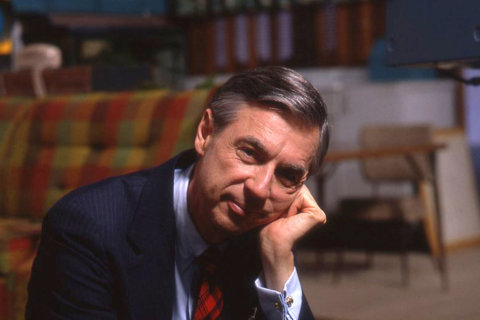For nearly half a century, “Mr. Rogers’ Neighborhood” taught children love, empathy and kindness on public television for 912 episodes from 1968-2001.
So it’s about time that Fred Rogers’ cultural moment has arrived, first with the PBS retrospective “It’s You I Like,” which aired in March 2018 narrated by Michael Keaton, then with Morgan Neville’s feature film “Won’t You Be My Neighbor?” — snubbed by the Oscars but my favorite documentary of last year.
Now, we get a narrative treatment in “A Beautiful Day in the Neighborhood,” a film that positions Tom Hanks for Best Supporting Actor rather than Best Lead Actor because he’s surprisingly not the main character. If you know that going in, you’ll love the movie. Just don’t expect it to be Fred Rogers’ life story in a traditional biopic, as this film has loftier goals regarding the redemption of others around us.
The plot follows cynical New Yorker Lloyd Vogel (Matthew Rhys), a magazine journalist who is assigned to do a profile on Mr. Rogers. He doesn’t want to do it, thinking it’s beneath him as an edgy gonzo journalist and thinking it’s not humanly possible for anyone to be as kind as Mr. Rogers portrays on TV. However, after visiting the set, conducting interviews and witnessing random acts of kindness, he becomes a Mr. Rogers believer to write a glowing article on the national icon.
By now, Tom Hanks is a national treasure. He’s able to take on any role in any genre with an aw-shucks likability we haven’t seen since Jimmy Stewart. Right from the jump, he absolutely transforms into Mr. Rogers, singing the catchy title song, fumbling with the zipper of his red sweater and tossing his sneaker from one hand to the other. Hanks masters Rogers’ fragile demeanor and soft-spoken delivery to the point that we feel like he’s our parent speaking to the child in us.
He’s so good that you almost wish we spent more time with him. Instead, most of the screen time goes to Emmy winner Matthew Rhys (“The Americans”), who is based on real-life journalist Tom Junod. Rhys manages to earn our sympathy beneath his grouchy exterior as he grapples with his estranged father, played by the great character actor Chris Cooper (“American Beauty”), and leans on his wife Andrea, a standout performance by Susan Kelechi Watson (“This Is Us”).
Director Marielle Heller (“Can You Ever Forgive Me?”) uses a contrasting palette to show light and dark in the world, from the bright lights and colorful sets of “Mr. Rogers’ Neighborhood” to the gritty shadows of New York alleys and bars. Most impressively, she uses miniature models not only in the opening credits to mimic the TV show intro, but throughout the film as playful transitions between scenes.
From the opening trolley sounds, you’ll melt into a wave of nostalgia with visits by postman Mr. McFeely (Daniel Krell), traffic signals as wall decorations and the video screen of Picture Picture. Once we enter the Neighborhood of Make-Believe, we meet Lady Aberlin (Maddie Corman) and puppets King Friday, Lady Elaine Fairchilde and Daniel Tiger, who embodies Fred’s childhood insecurities.
Sure, the script could have delved more into Fred’s childhood roots and what makes him tick, but every screenwriter has to decide what angle they’re going to take on a biopic. Here, co-writers Micah Fitzerman-Blue and Noah Harpster were most inspired by Junod’s 1998 Esquire magazine article “Can You Say… Hero?” So, rather than follow Rogers’ life chronologically, they use a framing device of Rogers opening panels of a picture board to introduce us to protagonist Vogel.
As we further explore the jaded journalist’s life, the writers dutifully set up why he has become so cynical in order for Rogers to provide the juxtaposition. Along the way, the script deftly balances the heavier themes of family forgiveness with comical moments showing how even the most hardened among us can become transfixed by Rogers’ childlike wonder. It even addresses the rumor that Rogers was formerly a cold-blooded sniper, a claim that has been repeatedly debunked.
The film’s most memorable scene — shown in the trailers — finds Rogers on a subway car as kids and adults of all colors and creeds recognize him and launch into an impromptu rendition of “Won’t You Be My Neighbor?” Yes, you could argue that this scene is contrived, but it’s entirely plausible considering the power of television and the number of kids from all different backgrounds watching it.
Last year’s documentary chronicled a pivotal moment in U.S. race relations when Rogers, a devout Christian and lifelong Republican, invited his gay African-American co-star François Clemmons to wash his feet with him in a kiddie pool at a time when public swimming pools were still segregated. Rogers was his own brand of quiet revolutionary, bringing people together with everyday kindness.
As such, moments like the subway scene are vital. Audiences relish in it because we need it. In an age of political vitriol, name calling and Twitter tirades, society needs a return to decency. We need to make America good again. As Rogers would say, it’s such a good feeling, a very good feeling, the feeling you know.









